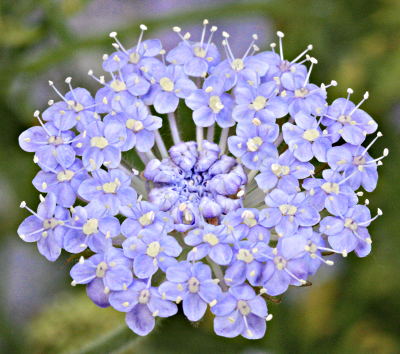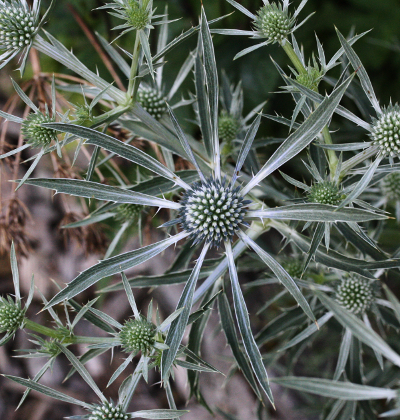Celery family |

The
blue lace flower (Trachymene
coerulea)
comes from South Australia

The useful plants of the celery family often bloom yellow as here of fennel (Foeniculum vulgare)

Eryngo, here Eryngium
amethystinum,
forms simple, head-shaped umbels
The old name of the family is Umbelliferae ("umbrellaed"), because the small flowers stand closely together and arranged umbrella-shaped. One speaks of an umbel, when the flower stems radiate out from a single point at the end of the stem.
The more than 400 genera and 3000 species comprising celery family consists of annual to perennial herbs. The stems are often hollow, hairy and nodose. The alternate arranged leaves are often pinnate multiply or pinnatipartite, in the subfamily Saniculoideae they are usually undivided. Stipules are usually absent, but prominently visible leaf sheaths. The plants of the African subfamily Mackinlayoideae are usually woody.
The inflorescence is usually a compound umbel: At the end of the stem all stalks derive from a single point. At the end of stalks another umbel is formed. This umbel of secundary degree is called "umbellule", its bracts (leaves at the junction of umbellules) are called "involucel". The bracts of the umbels are called "involucre".
The flowers at the end of umbellules often lie in a plane, so that "umbrellas" are generated. The flower stalks at the edge of the umbellules are therefore usually somewhat longer than that in the middle. The small, mostly white flowers, often missing the calyx or it is very small. There are 5 petals and 5 stamens. In some species the outer petals of the outer flowers are enlarged so that the flower is asymmetric. There are 2 styles arise from a disc (also called stylopodium), that possess nectar glands.
| Floral formula: |
| *–↓ K0–5 C5 A5 G(2) inferior |
From the ovary forms after pollination by flies and beetles a schizocarp which consists of two parts. The half-fruits each have 5 ribs, the lateral ones may be winged. Sometimes the fruits are smooth or spiny.
Apiaceae are represented all over the world, mainly in the temperate zones of the northern hemisphere.
Interesting notes
-
Many Apiaceae are cultivated, including vegetables such as carrot, celery, parsnip, root parsley and fennel.
As aromatic herbs parsley, chervil, dill, caraway, cumin, coriander, lovage and anise are used. However, not all Apiaceae are harmless: hemlock, cowbane and fool's parsley eg. are highly toxic!
Popular bedding plants of the family are Eryngo (with uncharacteristic head-shaped inflorescences) and the Astrantia (with a simple umbel). Goutweed (Aegopodium podagraria) can also be found in gardens, but is usually not welcomed there.
The flowers are usually protandrous, that is, first mature the stamens and only after that the carpels. Through this mechanism, self-pollination is prevented.